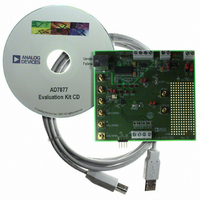EVAL-AD7877EBZ Analog Devices Inc, EVAL-AD7877EBZ Datasheet - Page 18

EVAL-AD7877EBZ
Manufacturer Part Number
EVAL-AD7877EBZ
Description
BOARD EVALUATION FOR AD7877
Manufacturer
Analog Devices Inc
Datasheets
1.AD7877ACBZ-REEL7.pdf
(44 pages)
2.EVAL-AD7877EBZ.pdf
(16 pages)
3.EVAL-AD7877EBZ.pdf
(44 pages)
Specifications of EVAL-AD7877EBZ
Main Purpose
Interface, Touch Screen Controller
Embedded
No
Utilized Ic / Part
AD7877
Primary Attributes
4-Wire Resistive Touch Screen Controller, SPI Interface, On-Chip: Temp Sensor, Voltage Reference, 8-Bit DAC
Secondary Attributes
USB GUI, LCD Noise Reduction Feature, 2.7 ~ 5.25 V, Wake Up on Touch Feature
Lead Free Status / RoHS Status
Lead free / RoHS Compliant
AD7877
Temperature Calculations
If an explicit temperature reading in °C is required, then this is
calculated as follows for the single measurement method:
1.
2.
3.
4.
5.
Example:
The internal 2.5 V reference is used.
1.
2.
3.
4.
5.
To calculate the temperature explicitly using the differential
method:
1.
2.
3.
Example:
The internal 2.5 V reference is used.
1.
2.
3.
Calculate the scale factor of the ADC in degrees per LSB:
Degrees per LSB = ADC LSB size/−2.1 mV =
(V
Save the ADC output, D
Temperature T
Take ADC reading, D
measured, T
Calculate the difference in degrees between T
using
ΔT = (D
Add ΔT to T
Degrees per LSB = (2.5/4096)/−2.1 × 10
The ADC output is 983 decimal at 25°C, equivalent to a
diode forward voltage of 0.6 V
The ADC output at T
ΔT = (880 − 983) × −0.291 = 30°
T
Calculate the LSB size of the ADC in V:
LSB = V
Subtract TEMP1 from TEMP2 and multiply by LSB size to
get ΔV
Multiply by 2490 and subtract 273 to obtain the
temperature in °C
LSB size = 2.5 V/4096 = 6.1 × 10
TEMP1 = 880 and TEMP2 = 1103:
ΔV
T = 0.136 × 2490 − 273 = 65°C
AMB
REF
BE
/4096)/−2.1 mV
= 25 + 30 = 55°C
= (1103 − 880) × 6.1× 10
BE
REF
AMB
/4096
− D
AMB
CAL
CAL
CAL
) × degrees per LSB
AMB
AMB
CAL
, at the temperature to be
is 880
, at the Calibration
−4
−4
= 0.136 V
V(610 μV)
−3
= −0.291
CAL
and T
AMB
Rev. B | Page 18 of 44
BATTERY MEASUREMENT
The AD7877 can monitor battery voltages from 0.5 V to 5 V on
two inputs, BAT1 and BAT2. Figure 34 shows a block diagram
of a battery voltage monitored through the BAT1 pin. The
voltage to the V
desired supply voltage via the dc/dc regulator while the input
to the regulator is monitored. This voltage on BAT1 is divided
down by 2 internally, so that a 5 V battery voltage is presented
to the ADC as 2.5 V. To conserve power, the divider circuit is on
only during the sampling of a voltage on BAT1. The BAT2 input
circuitry is identical.
The BAT1 input is ADC Channel 0110b and the result is stored
in Register 10110b. The BAT2 input is ADC Channel 0111b and
the result is stored in Register 10111b.
Figure 34 shows the ADC using the internal reference of 2.5 V.
The maximum battery voltage that the AD7877 can measure
changes when a different reference voltage is used. The maxi-
mum voltage that is measurable is V
gives a full-scale output from the ADC. If a smaller reference is
used, such as 2 V, then the maximum measurable battery voltage
is 4 V. If a larger reference is used, such as 3.5 V, then the maxi-
mum measurable battery voltage is 7 V. The internal reference is
particularly suited for use when measuring lithium-ion batteries,
wherein the minimum voltage is about 2.7 V and the maximum
voltage is about 4.2 V. A proper choice of external reference
ensures that other voltage ranges can be accommodated.
0.5V TO 5V
BATTERY
Figure 34. Block Diagram of Battery Measurement Circuit
CC
pin of the AD7877 is maintained at the
CONVERTER
BAT1
DC-DC
5kΩ
5kΩ
SW
0.25V–2.5V
REF
V
CC
× 2, because this voltage
V
ADC
REF




















